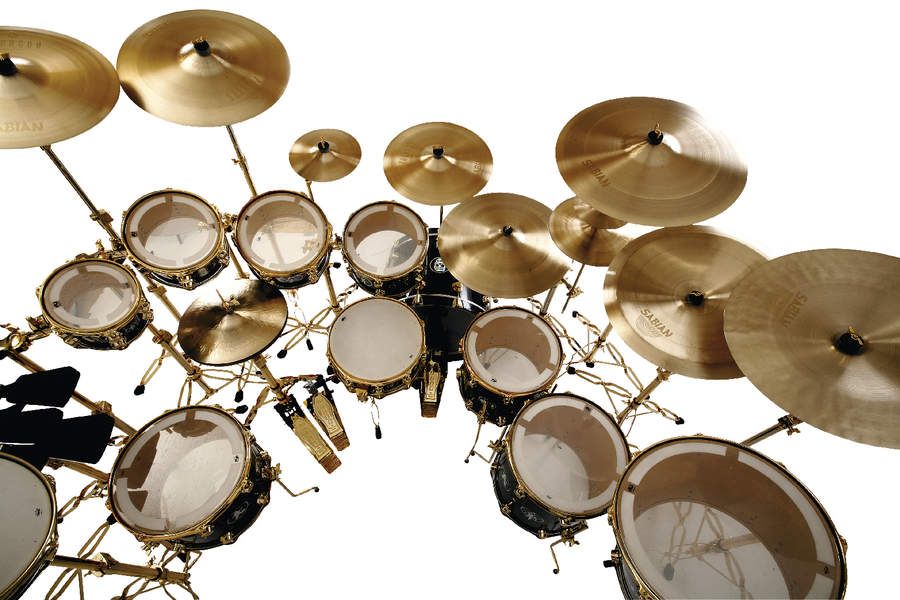This is a perfect drum for beginners or for children due to its scale and size. It features: 10 different colors (green, red, blue, black, purple, pearl, orange, silver, grey, and plum) Mallets; A carry bag; Light-weight, brightly colored, wear and tear-resistant, the 10” Steel Tongue Drum is a solidly made entry-level steel tongue drum. It comes with 5 integral pieces which include a bass drum (22x17), snare drum (14x5.5), and tom’s in the following sizes: 10x7, 12x8, 16x15. The set produces a range of warm tones. Setting up is made easy with the included stoppers, and the claw hooks that come included work nicely to reduce noises.
Ask any drummer what the most precious element of his kit is and chances are they’ll tell you it’s the snare.
Why? Well…
Look at it this way:
Imagine you were playing a gig and suddenly your whole kit broke apart, leaving you with only ONE element (which would suck, I agree), which one would you prefer to have left?
- Perfect Drums TCI is a special version of Perfect Drums created for use with the Slate TRIGGER plugin. It contains 54 instruments found in the factory sound library: 13 kick drums 12 snare drums.
- So although the vast majority of drummers use wood snare, metal is not uncommon and is often found in rock and metal bands. As for acrylic, it’s much rarer, mainly because most drummers don’t seem to be 100% comfortable playing on them, but also because not all drums manufacturers produce it yet. Acrylic snare are mainly found in rock and funk.
- You can also find synthetic shells (usually bass and toms) made of acrylic, fiberglass, or carbon fiber And metal shells (usually snares) made of steel, aluminum, copper, or bronze.
The snare, most probably, because you can play :
- The upbeat,
- The backbeat…
- And fill everything in between with it, which undoubtedly makes it the most versatile element of the kit.
And while this can be discussed, the truth is it is not uncommon to see drummers travel with only their snare(s) when touring, which they use with whatever drumkit is available at their next venue.
Some drummers like to keep different models on hand and some even play with several at the same time, to alternate sounds.
So even when budget is tight, drummers NEVER skimp on the snare choice, even if it means acquiring a lower quality drumset.
So…
How do you choose the right snare for your playing? And how do you get that perfect snare sound? Well these are the questions I’ll try to answer in today’s article.
Sounds good?
Then let’s start.
First up…
What is a snare drum?
So, first off, let’s explain briefly what a snare drum is and how it’s made.
A snare drum is a drum that has the unique characteristic of having snares built to it (crazy, huh?).
The snares are thin metal wires stretched under tension that strike the resonant head, as well as themselves when the batter head is struck.
And this produces the famous ‘crack’.
Originally, snare heads were made out of calf skin and snare wires out of cat gut, which are now replaced respectively by plastic and metal.
To learn about the different types of shells, hardware and construction, check out this article:
Next up…
Sizes
There are almost endless combinations of depth and diameter available, but some sizes and models are more popular than others.
These models have names which are common to most drum companies and are usually given according to either the diameter, or the depth of the snare.
And so, depending on the depthwe have these:
- piccolo – have a depth range of 3″ to 4.5″
- standard – have a depth range of 4″ to 6.5″
- deep – have a depth range of 7″ to 10″
Perfect Drums Free
And depending on the diameter, we have these:
- popcorn – have a diameter of 10″
- soprano – have a diameter of 12″ to 13″
- standard – have a diameter of 14″
Now in terms of sound, you might think that a deeper snare produces a lower sound and a shallower snare produces a higher sound…
Well this is actually not correct. In fact, the depth of the snare affects the “body” or “fullness” of the sound, while the diameter affects the pitch.
And so:
- Deeper snares – produce a “fatter sound” especially when tuned low. They are common in pop, rock and their sub-genres.
- Shallower snares – produce more of that “crack” sound and are common in jazz, funk and other related genres. They’re also more responsive due to the lower distance between the batter head and the snare wires.
Here’s a useful video comparing different models with a wide range of depths :
Got it? Then let’s move on to the next most important characteristic…
Materials
Snare drums, just like the rest of the elements of a drumkit can be made out of various materials which all influence and shape the sound of the snare.


These are, ordered by popularity:
- Wood – which is the richest in bass and mids. Due to the amount of different woods available, it’s also the most versatile material.
- Metal – which produces the brightest tone of all materials. It has a longer sustain and a very “incisive” rimshot.
- Acrylic – which produces a “fatter” sound and a very loud crack.
So although the vast majority of drummers use wood snare, metal is not uncommon and is often found in rock and metal bands.
As for acrylic, it’s much rarer, mainly because most drummers don’t seem to be 100% comfortable playing on them, but also because not all drums manufacturers produce it yet. Acrylic snare are mainly found in rock and funk.
Check out this video to hear the difference between the 3 materials for yourself:
Next up…
Snare Wires
For some reason, snare wires are probably the most disregarded part of the snare, and generally of the whole drumkit.
Most drummers don’t care about them and really just don’t know much about them…
Until something goes wrong and that sweet ‘crack’ sound becomes a dull ‘boom’, turning your beloved snare into nothing more than a simple tom.
And so in order to prevent this dire outcome, there are a few things you need to know about snare wires…
The first one being their 2 main sound altering characteristics:
- The amount of wires – which can be 16, 20, 24 and even 30.
- The thickness of the wires – the thinner, the more sensitive.
Now, one of the biggest name in the industry, Puresound Percussion actually did some studies on snare wires (that’s how serious they are on the subject) and found that:
- With 16 strands you get approximately half snare sound/half drum shell sound
- With 20 strands you get more snare sound than drum sound, and…
- With 24 strands the snare sound is increased even more, and so on
So, to sum it up. the more and thinner strands, the more sensitive the snare will be. So if you play jazz and need a very sensitive snare that can respond to the slightest brush movement, choose thin strands…
And if you’re a heavy hitter and need snare wires that can withstand the roughest hits, go for thicker strands.
To get an idea of the difference you’ll get between stock wires and separately bought wires, check out this video:
Here are the snare wires I recommend:
- PureSound Blaster Series (20 strands) – (Amazon/GuitarC/MusicianF/Thomann)
- PureSound Custom Pro (20 strands) – (Amazon/GuitarC/MusicianF/Thomann)
- PureSound Super 30 Series(30 strands) – (Amazon/GuitarC/MusicianF/Thomann)
- Sabian Phosphore (42 strands) – (Amazon)
- PureSound Equalizer (16 strands) – (Amazon/Thomann)
- PureSound Equalizer (12 strands) – (Amazon/Thomann)
Next up…
How to tune your snare
Once you’ve decided what material, diameter and depth you want…

The last step is to decide how you want to tune your snare. And let me tell you, you don’t want to overlook this part.
In fact, many drummers agree that you may buy the best or most expensive snare drum ever, if you don’t tune it properly, you won’t get much out of it.
And so to help you reach the nirvana of snare tuning, here are some things you need to know:
There are 3 main “levels” of tension:
- Tight,
- Loose, and…
- Medium
And there are 3 main tuning combinations between batter and resonant head:
- Top head tight/bottom head loose;
- Top head loose/bottom head tight;
- or both heads with equal tension.

Now, to understand how tuning affects sound, let’s have a look at what happens when the batter head is struck:
First, the resonant head is pushed downward by the air, pushing in turn the snare wires away. It then snaps back in its original place, followed by the wires which produce the distinctive cracking sound as they slap the resonant head.
And so:
- The looser the resonant head, the less resistance to the air. This makes heads and wires recovery time greater and makes snare wires reaction weaker and slower. You won’t
- The tighter the head, the shorter it will take for it to come back in its original place because of air resistance, same for the snare wires.
Beware of over-tensioning the head though, you might end up with no “snap” whatsoever.
Check out this video for a good sound depiction of what I just described:
Next up…
How to choose a drumhead
Another important factor to shape your snare sound is choosing the right head.
So if you’d like to learn more about drumheads, check out this article:
Next up…
Recommended Snare Drums
For this list I decided to include the best snares in each category I covered in this article. I also decided to stay away from off-brands and only focus on the most famous drum manufacturing companies as they provide the most consistent and reliable quality.
UNDER $300:
Best standard snares:
- Yamaha Stage Custom (birch) – (Amazon/B&H/GuitarC/MusicianF/Thomann)
- Ludwig Steel Snare – (Amazon/GuitarC/MusicianF/Thomann)
- DW Design Series(acrylic) – (Amazon/GuitarC/MusicianF)
- Mapex Snare Drum (maple) – (Amazon)
- DW Chad Smith Signature(acrylic) – (Amazon/GuitarC/MusicianF/Thomann)
Best deep snares:
- Mapex MPX Series (maple) – (Amazon)
- Ludwig Supralite (steel) – (Amazon/GuitarC/MusicianF/Thomann)
- Tama S.L.P. BigBlack (steel) – (Amazon/GuitarC/MusicianF)
- Ludwig Black Magic (brass) – (Amazon/GuitarC/MusicianF/Thomann)
- DW Chad Smith Signature(acrylic) – (Amazon/GuitarC/MusicianF/Thomann)
Best piccolo snares:
- Mapex Piccolo 13″ (steel) – (Amazon/GuitarC/MusicianF)
- Mapex Piccolo 14″ (steel) – (Amazon/GuitarC/MusicianF)
- Pearl Black Steel (steel) – (Amazon/Thomann)
- Pearl Brass Piccolo (brass) – (Amazon/Thomann)
- Pearl Maple Piccolo (maple) – (Amazon/GuitarC/MusicianF)
Best popcorn snares:
- Pearl Short Fuse (poplar) – (Amazon/GuitarC/MusicianF/Thomann)
- Gretsch Silver Series(poplar) – (GuitarC/MusicianF/Thomann)
- Gretsch Brooklyn Series(Steel) – (GuitarC/MusicianF)
- TAMA Soundworks(Steel) – (GuitarC/MusicianF/Thomann)
Perfect Drums Free Download
ABOVE $300:
Best standard snares:
- Pearl Joey Jordison Signature (steel) – (Amazon/GuitarC/MusicianF/Thomann)
- Ludwig LM402(aluminium) – (Amazon/GuitarC/MusicianF/Thomann)
- DW Collector’s Series(nickel/brass) – (Amazon/GuitarC/MusicianF/Thomann)
- Yamaha Sensitive Series(cherry wood) – (Amazon/GuitarC/MusicianF)
Best deep snares:
- Pearl Hybrid (fiberglass) – (Amazon/Thomann)
- Pacific by DW(bubinga/maple) – (Amazon)
- Tama S.L.P. (maple) – (Amazon/GuitarC/MusicianF/Thomann)
Best piccolo snares:
- Ludwig Carl Palmer Signature (maple) – (Amazon/Thomann)
Best popcorn snares:
- Pearl Popcorn (maple) – (Amazon)
Perfect Metal Drum Sound
And That’s It
So there you have it guys, The Ultimate Guide to Snare Drums. Hopefully you now know which type of snare you need, and how to get the best sound out of it.
‘Til next time.